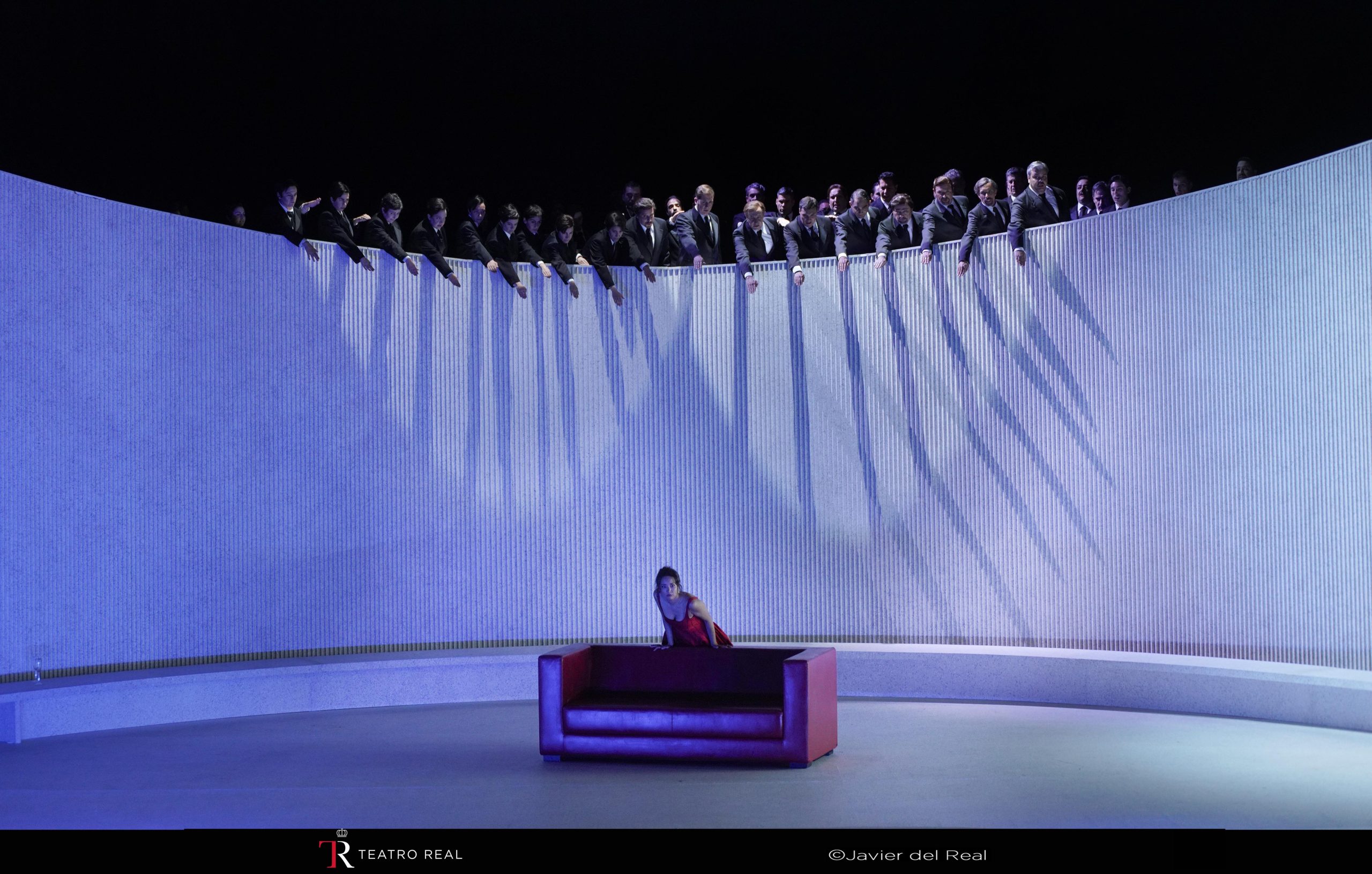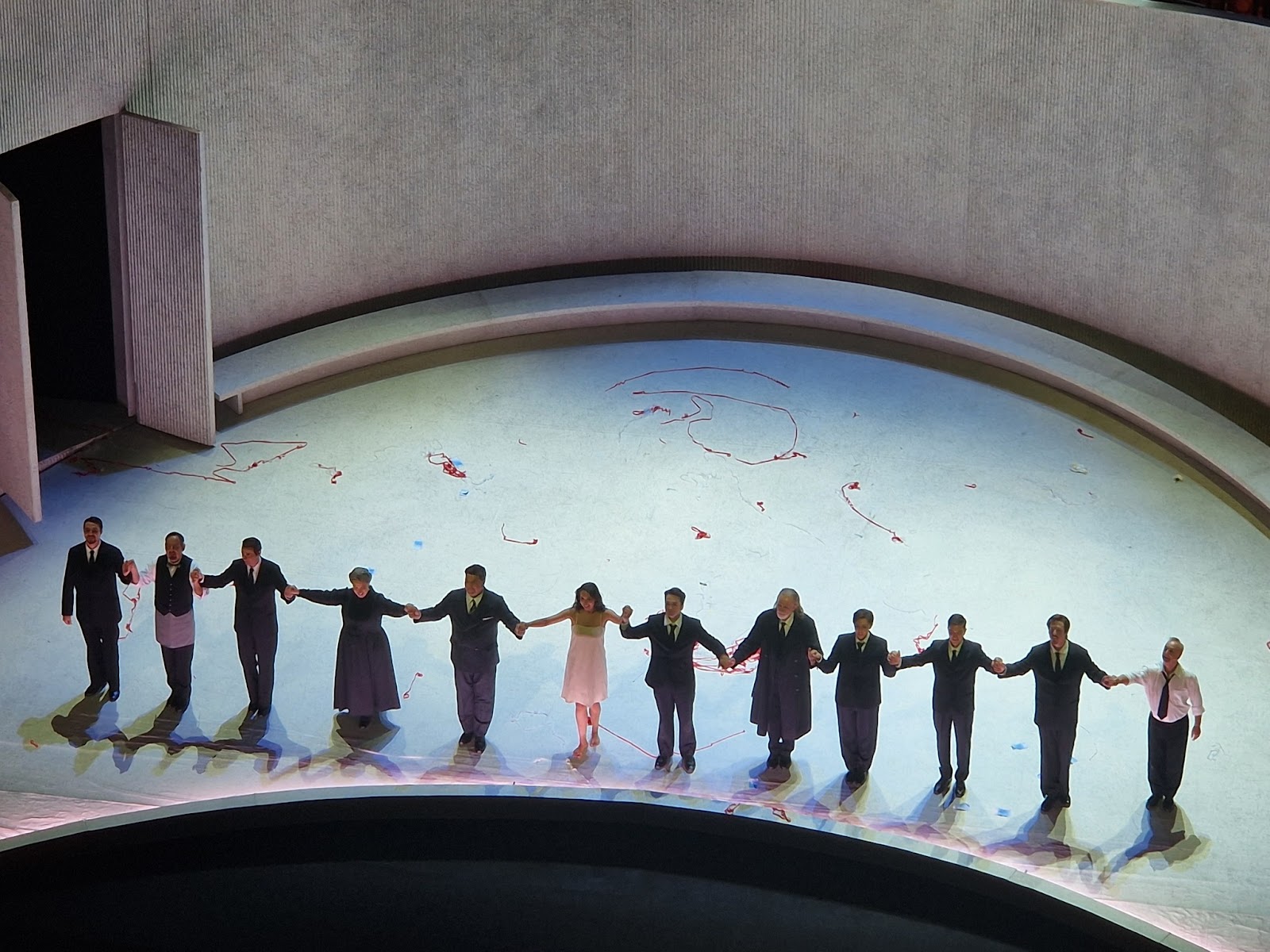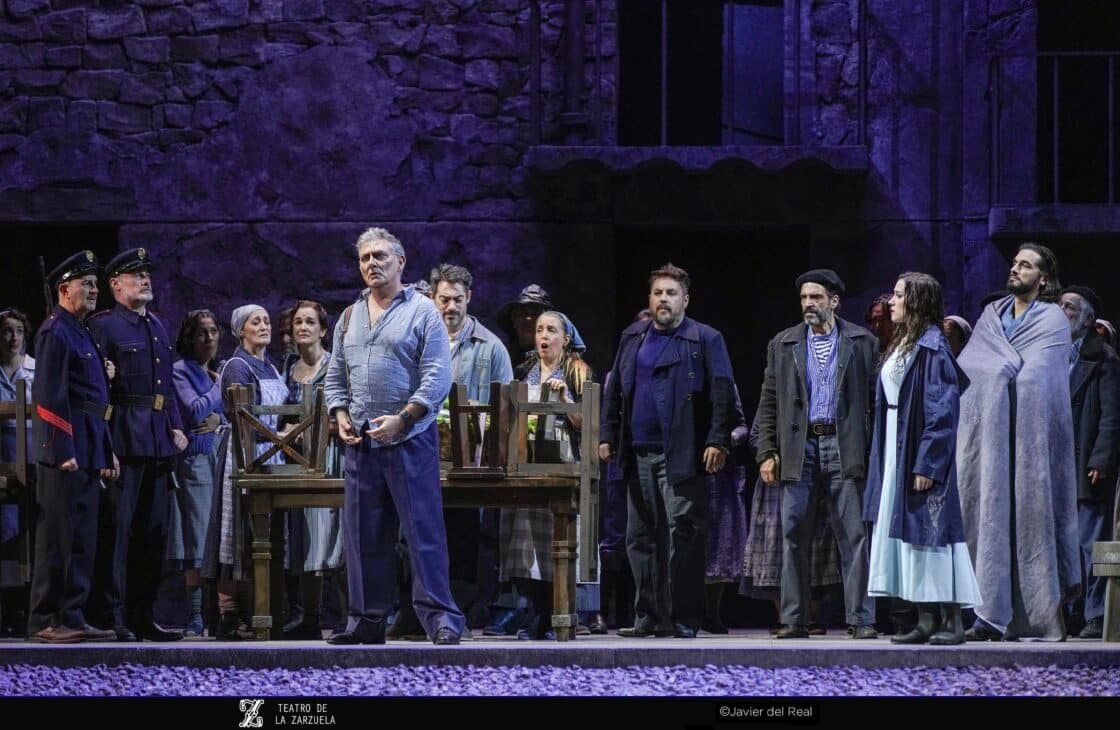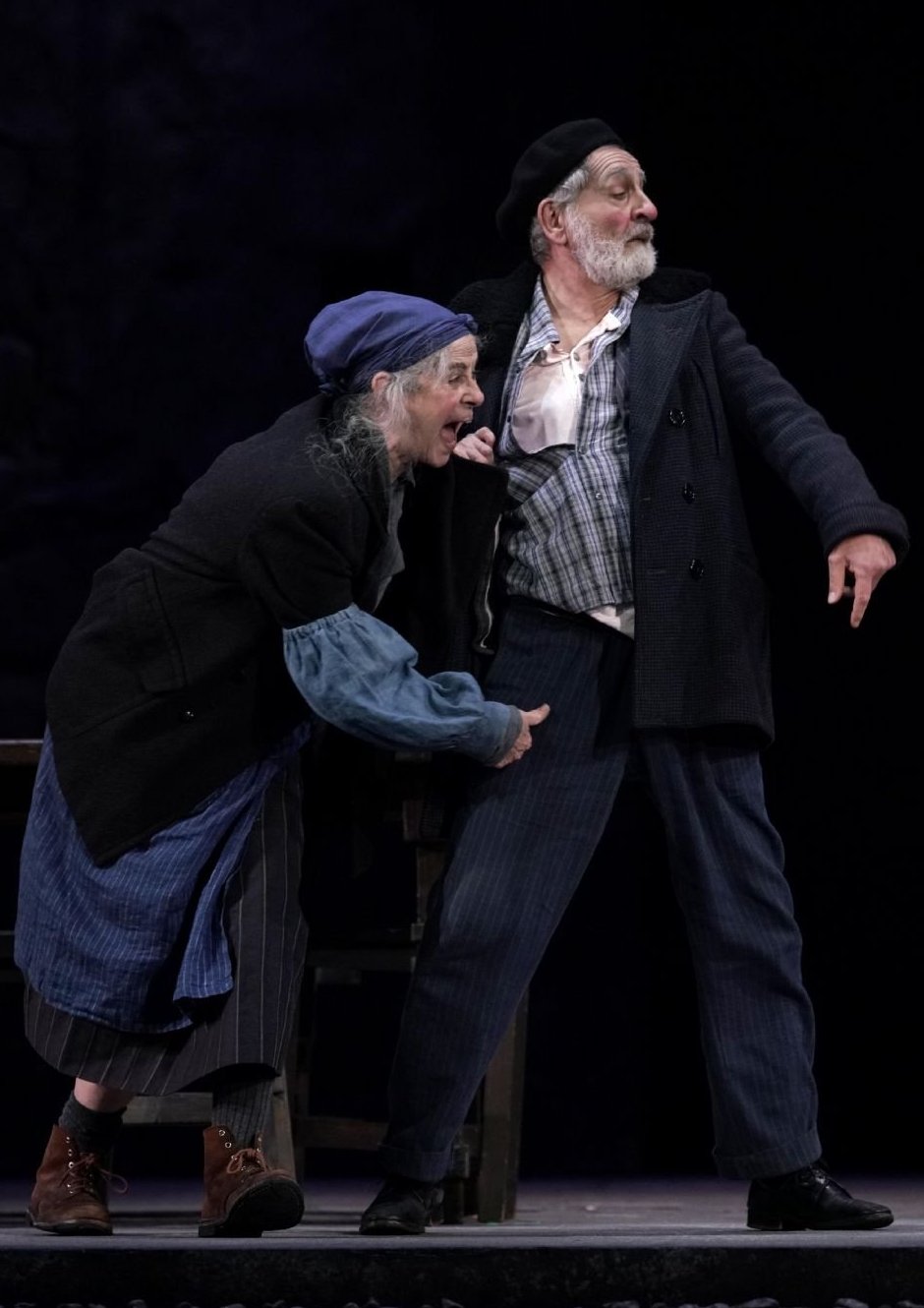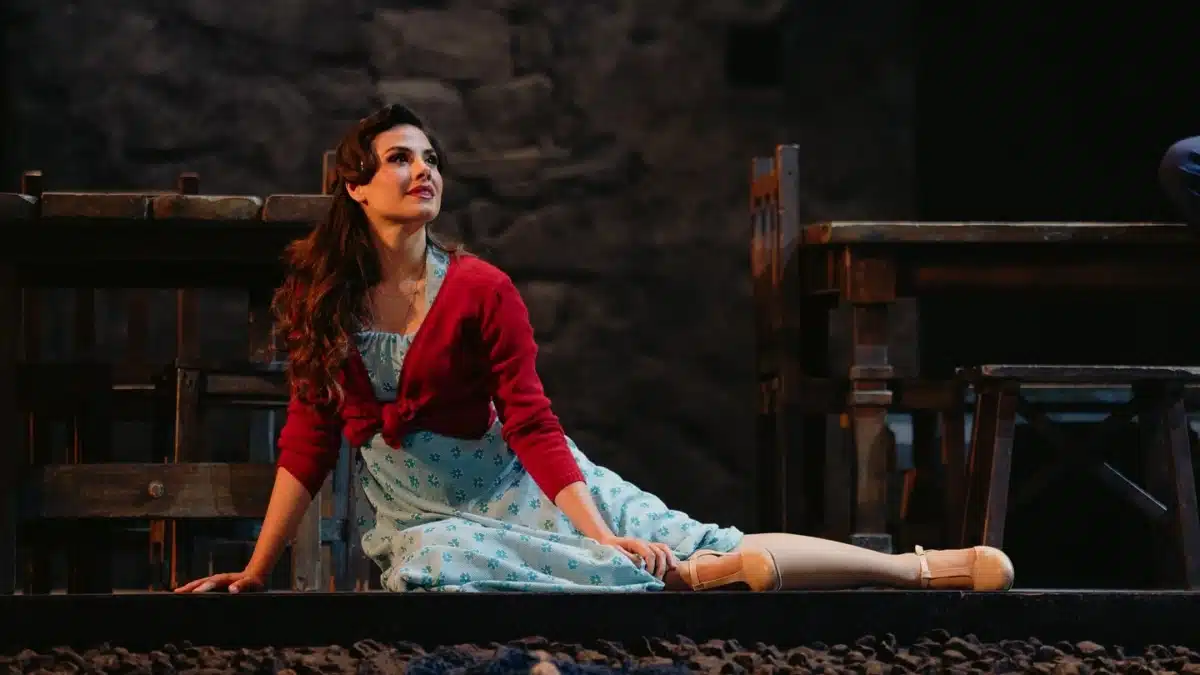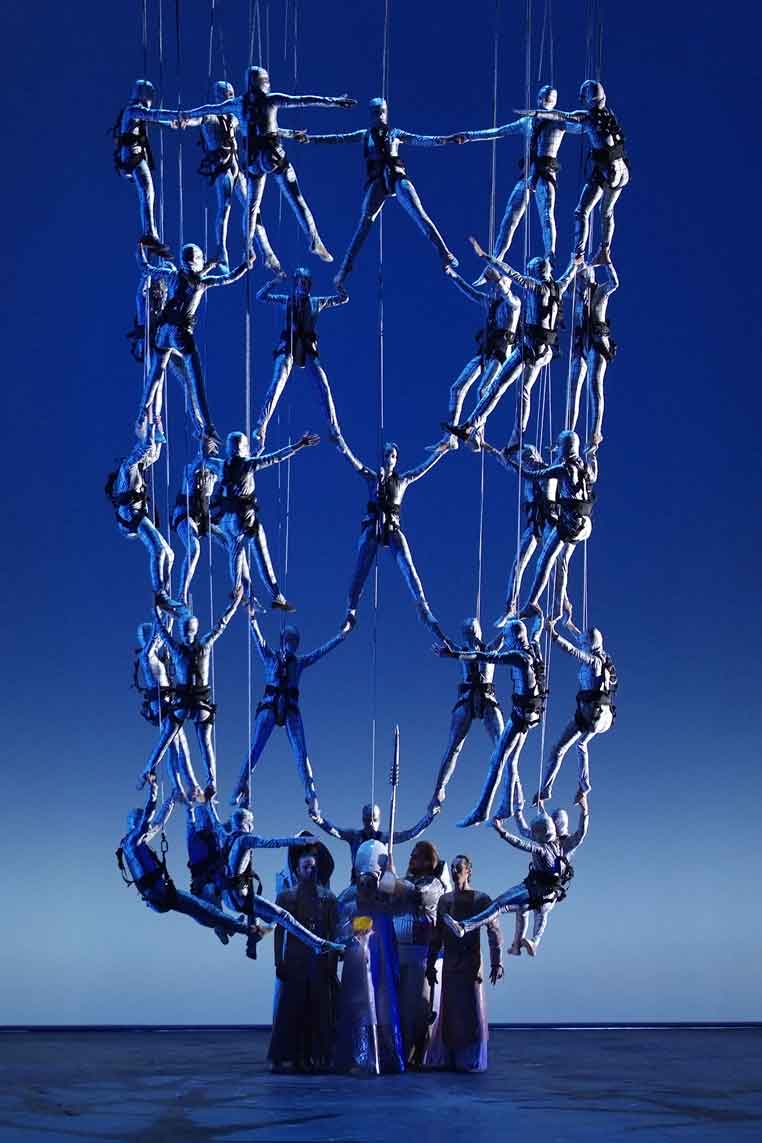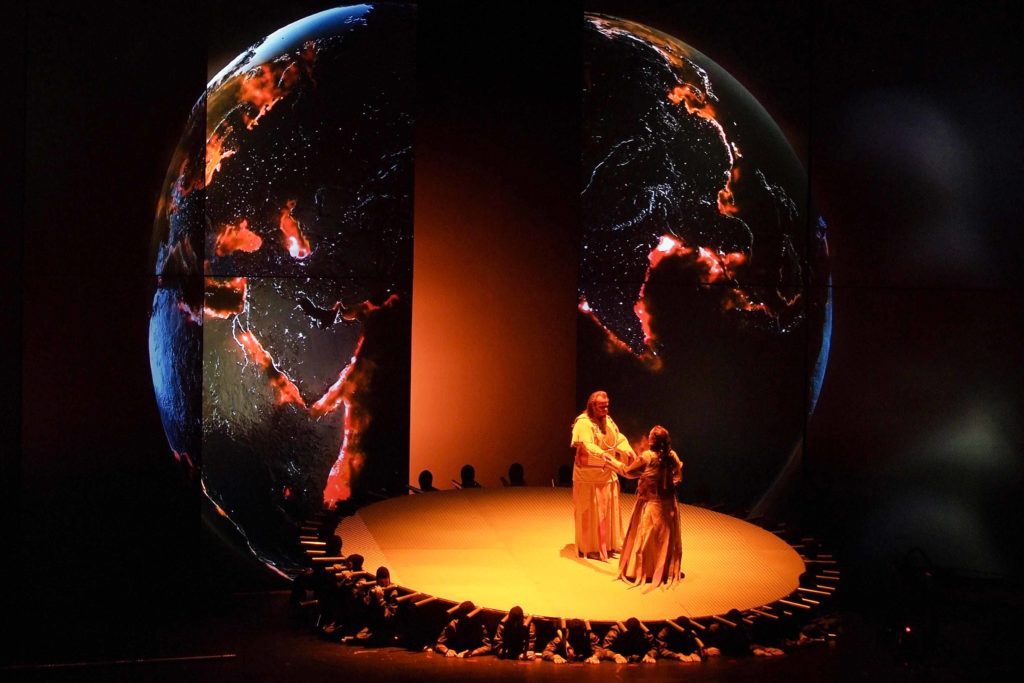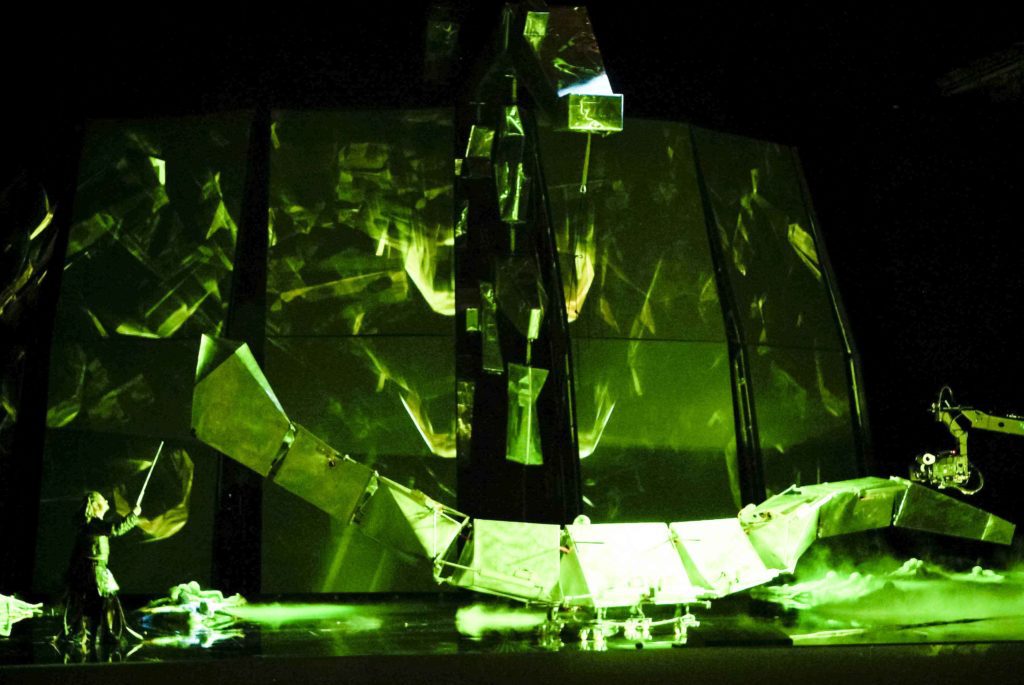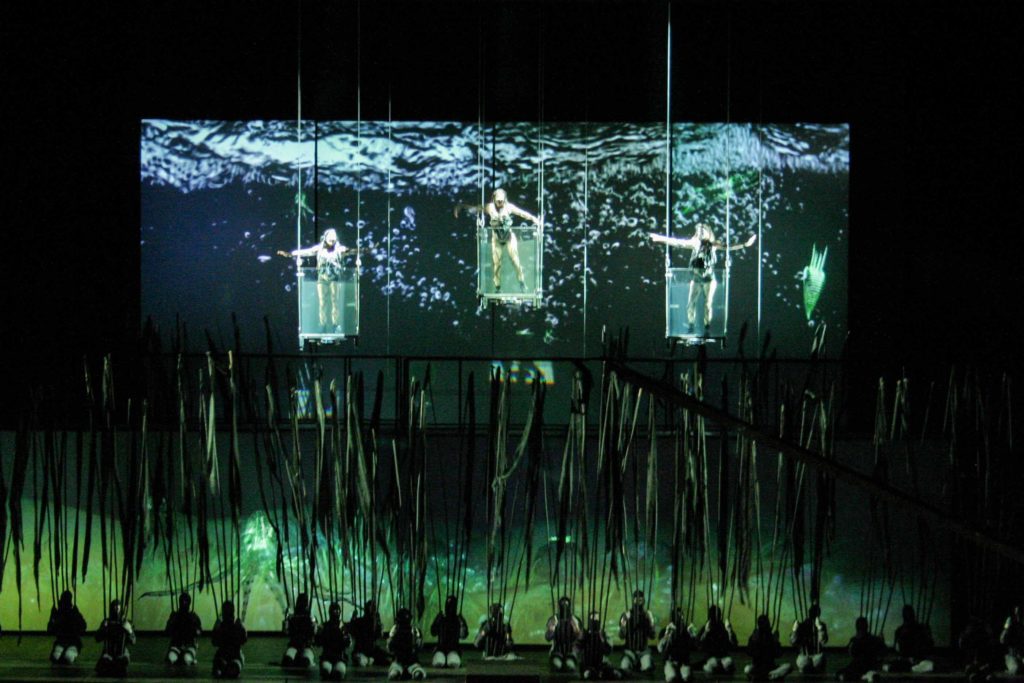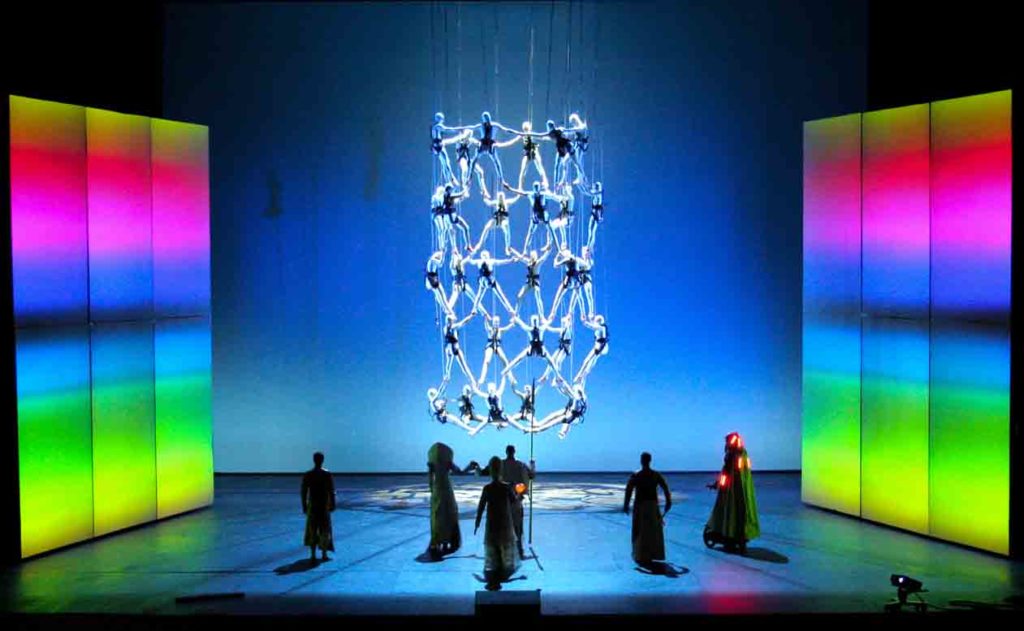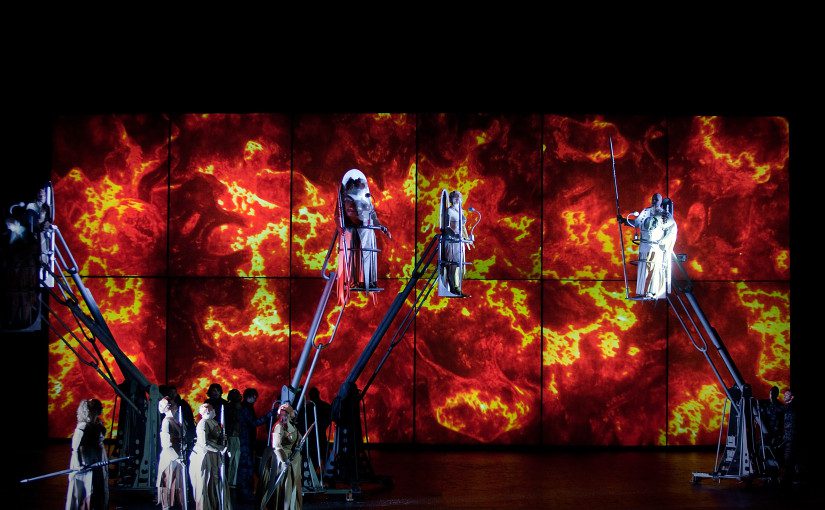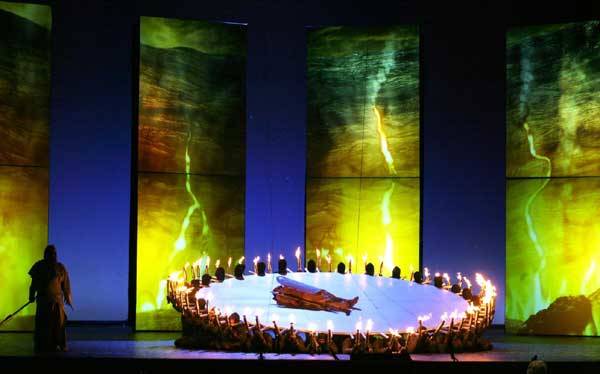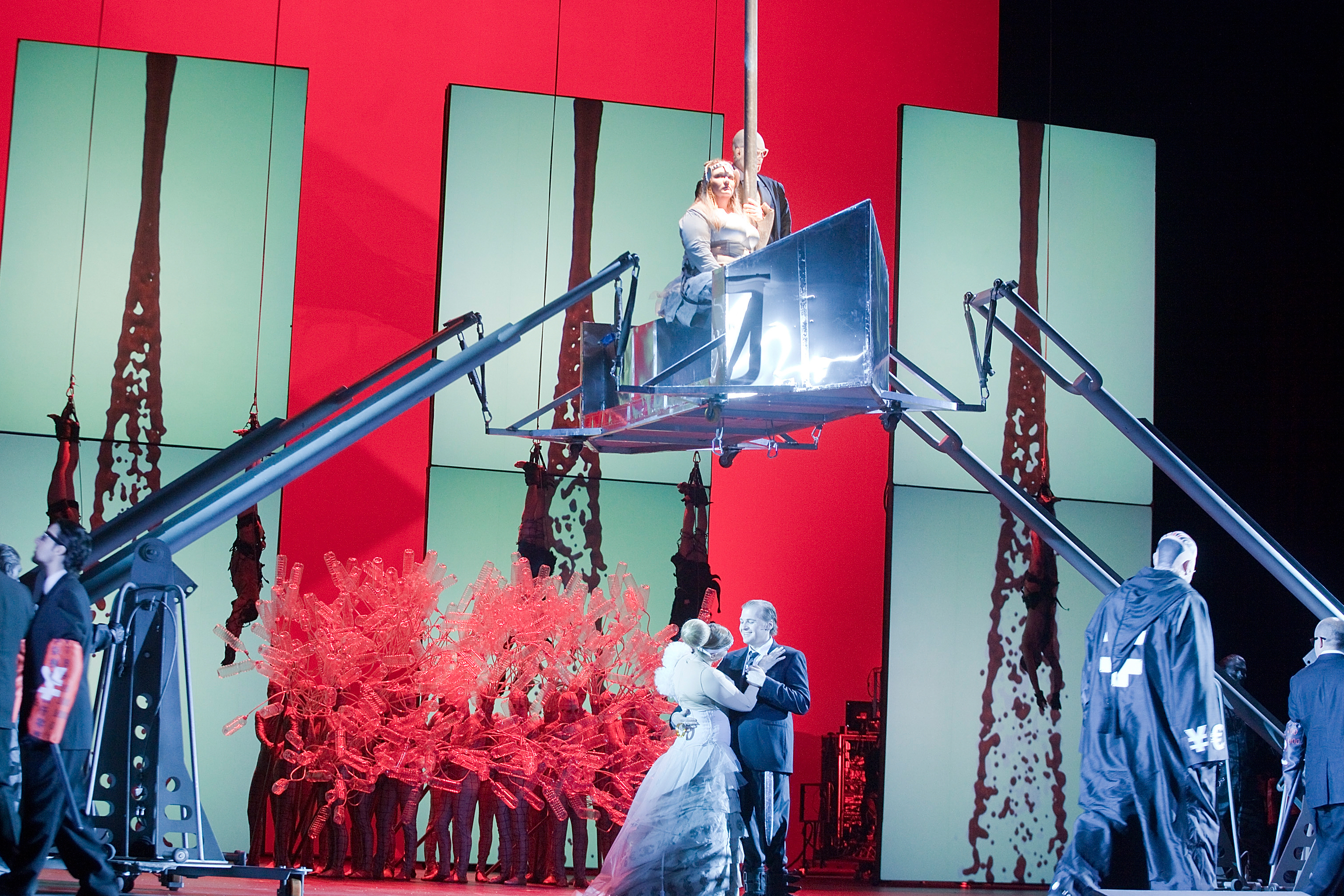lunes, 30 de junio de 2025
The desperate struggle of a dying woman: Willy Decker's Traviata at the Teatro Real.
La cruel tragedia de un juguete roto: La Traviata, al fin escenificada, en el Teatro Real.
Madrid, 29 de junio de 2025.
Cada vez que se programa La Traviata en el Teatro Real es un evento cultural y social: mención en los medios de comunicación, presencia de la flor y nata de la alta sociedad madrileña el día del estreno, el cartel de "No hay billetes" colgado en las taquillas, y si se tercia, emisión por televisión. Este año, además coincide con la Semana de la Ópera, con lo que habrá transmisión directa de una representación en pantalla gigante en la Plaza de Oriente, con afluencia de miles de personas, y a muchos centros culturales de España el 19 de julio.
Para este regreso, se ha contado con la famosa producción de Willy Decker, que se estrenó hace veinte años en el Festival de Salzburgo, con la diva rusa Anna Netrebko. Esta producción ha recorrido los principales teatros del mundo, con gran éxito, y se ha convertido en un clásico. En la temporada 2019-2020, el Real ya lo había programado para dos tandas de funciones en mayo y julio de 2020. Sin embargo, ese año tuvo lugar la pandemia por el Covid-19, que paró toda la actividad en el mundo y confinó a sus habitantes en sus casas en todo el planeta, lo que incluyó la paralización de la actividad operística, no había tiempo de pensar en ópera con tanta gente muriendo por coronavirus. Perdidas las funciones de mayo, cuando se anunció que en julio de ese año se iban a programar veintiocho funciones de esta ópera, con los repartos inicialmente previstos (excepto Nadine Sierra, Plácido Domingo como Germont padre, debido al escándalo surgido entorno a su persona; y el legendario Luigi Roni como el Doctor Grenvil ya que murió por Covid en marzo de ese año) , la sorpresa fue mayúscula. Finalmente, las funciones tuvieron lugar, con fuertes medidas de seguridad, en una versión semiescenificada (sin posibilidad aún de representar montaje alguno) que separaba a cantantes y coro en el escenario. Con este emotivo regreso de la ópera a la ciudad, también regresaba la ópera de primer nivel al mundo, pues el Real fue el primer teatro importante en volver a representarla.
Cinco años después, esta aclamada producción por fin llega a la capital, y con ella, el director de orquesta Henrik Nanási y la soprano Nadine Sierra, previstos para las funciones de mayo de 2020, y un par de secundarios de las funciones de julio de ese año; acompañados de nuevos elencos. En las navidades de 2022, Sierra y el tenor español Xabier Anduaga cautivaron al público del Teatro Real con La Sonnambula, y en la primavera pasada hicieron lo mismo en Barcelona con ese título. Ahora estos artistas, favoritos del público, vuelven a subirse a las tablas del Teatro Real para deleitarnos con la ópera más famosa del mundo, de la que son además reconocidos intérpretes.
La puesta en escena de Willy Decker sigue siendo tan dura y tan impactante después de dos décadas. Es una Traviata distinta a cómo estamos acostumbrados a verla, y al mismo tiempo tan fiel a la esencia de la historia, que sigue siendo vigente, ciento setenta y dos años después de su estreno. ¿Qué familia "bien" recibiría con agrado que su hijo tenga relaciones con una prostituta de lujo? Este tipo de personajes son víctimas de la hipocresía de la sociedad: son usadas como juguetes de placer, a las que se niega el derecho de rehacer su vida si intentan abandonarlo. De todo esto la minimalista producción se hace eco: no hay romanticismo, ni galanterías, ni trajes barrocos, ni salones lujosos ni habitaciones elegantes, aquí lo que importa es la tragedia de una mujer a la que le queda muy poco tiempo de vida, que sufre por intentar amar y luchar contra su inevitable muerte, y que la sociedad desecha tras haberse aprovechado de ella. Uno deja la función con una sensación de tristeza para con Violetta, y con indignación por su sufrimiento. Duele ver tanta crueldad para con una mujer enferma.
Nada más entrar al teatro nos espera ese curvo escenario blanco, con un enorme reloj, que representa el poco tiempo de vida que le queda, y cerca de él sentado el Doctor Grenvil, que representa la muerte. Al fondo, a veces se ve un mural de flores. La única mujer que importa aquí es Violetta, con su ya icónico vestido rojo. Los demás, son todos hombres babosos (incluso las mujeres, aquí vestidas de hombre salvo la sirvienta) que la rodean lujuriosamente. El reloj avanza rápidamente en el breve coro final del primer acto, acortando la vida de Violetta. El segundo acto empieza con Violetta y Alfredo jugando como una pareja juguetona, envueltos en batas floridas que se funden con las sábanas que cubren el sofá. La segunda escena de dicho acto no muestra a gitanas y toreros bailando, sino al coro enmascarado atormentando a Alfredo con un hombre con el mismo vestido rojo que lleva Violetta y acosándole sin parar,. Solo cuando, en la ya clásica escena en la que Alfredo humilla a Violetta tirándole el dinero para pagarle lo que ha gastado en él, el coro muestra algo de humanidad y aparece sin máscaras. Poco les durará: en el tercer acto, aparecerán para llevarse el enorme reloj, y poner encima de él a otra mujer vestida de rojo: el próximo juguete roto. En el triste tercer acto, el escenario más vacío que nunca, se ve a una Violetta débil, agonizante, ante la mirada antenta del doctor-muerte, a la que solo anima un poco la visita de Alfredo. De hecho, al final, la pobre muere sola ante la apática mirada de todos.
viernes, 20 de junio de 2025
El popular y costumbrista romance marinero: vuelve La Tabernera del Puerto al Teatro de la Zarzuela.
Madrid, 18 de junio de 2025.
Uno podría pensar que el exitoso montaje de Mario Gas para "La Tabernera del Puerto", de Pablo Sorozábal, tiene una especie de maldición sobre el mismo, después de que cada reposición haya venido acompañada de paros. En su estreno en 2018, hubo paros debido al temor entre la fusión del Teatro de la Zarzuela con el Teatro Real, lo que felizmente no se llevó a cabo. En 2020, se suspendieron las funciones debido al confinamiento por la pandemia del Covid-19. En 2021, una huelga de tramoyistas suspendió el estreno. Ahora en su reposición de 2025, una huelga del coro afectó el día del estreno, viendose este desprovisto de dicho coro. Ahora hay paros convocados para esta semana desde el día 19.
Cuando uno escucha la breve introducción orquestal, esas cuerdas evocando la brisa marina, respondidas por el metal que evoca el amanecer que dora las costas de Cantabreda, uno piensa ¡qué bonita música escribe Sorozábal! Siente uno ese frescor como si se estuviera en una playa, y eso que la obra acaba de empezar. Es una constante en el catálogo del maestro vasco, tanto en obras como esta, La del Manojo de Rosas, Katiuska, Adiós a la Bohemia, o en su poco conocida y genial ópera Juan José. Durante su longeva vida, presenció los últimos grandes años del género, siendo esta Tabernera considerada como una de las últimas grandes zarzuelas; y posteriormente los años dorados de las grabaciones del género, dirigiendo la orquesta en muchos álbumes clásicos.
Este costumbrista romance marinero, sobre una misteriosa mujer que despierta la fascinación de los hombres y el recelo de las mujeres del pueblo; y que se divide entre la compañía tóxica de un hombre y el amor sincero de otro, posee una música fascinante, moderna y diversa. Muchos melómanos en el extranjero conocen la dramática y emocionante romanza "No puede ser", debido a muchos discos y conciertos de zarzuela, protagonizados por Plácido Domingo, quien hizo popular la pieza en el mundo lírico. Es un número que casi siempre logra que a su término, el teatro se suela venir abajo en ovaciones al tenor de turno. No es para menos, el efecto de emoción del miedo y la reticencia de Leandro sobre lo que Simpson le ha contado sobre Marola se extienden al público con esa música tan hermosa que se mide de tú a tú con las más famosas arias de ópera para tenor. Pero hay mucho más: la romanza de Marola, En un país de fábula, es deudora de la coloratura operística, o el Despierta negro o la romanza final de Eguía son de un interesante eclecticismo. El primero, mezclando lo melancólico de las memorias de Simpson con ritmos de percusión que se asocia a la música negra, casando con el pasado de este personaje en alguna plantación americana; y el segundo, un soliloquio con una música bastante operística, una escena de locura.
Sobre el montaje de Mario Gas ya hablé en su momento en 2021, aunque poco más hay que decir. Se trata de una producción clásica, respetuosa con el argumento original, haciéndolo fácilmente identificable: unos edificios de piedra que representan un pueblo pesquero en el primer acto, una taberna igualmente de piedra en el segundo, presidida por una difuminada imagen de la Virgen. El tercer acto recrea el bote donde Leandro y Marola cargan la cocaína, en la que el mar es representado por proyecciones de violentas olas. En una obra donde el mar es más latente que patente, pero no deja de sentirse; la producción sitúa en el borde del escenario una pequeña playa con agua real y una orilla con piedras. No obstante, un punto en contra, aunque comprensible. Debido a la necesidad de dar tiempo a que cambie la escena, el animado interludio orquestal (una versión instrumental del dúo cómico de Antigua y Chinchorro en el primer acto) entre las dos escenas del tercer acto, suena mientras se proyecta a telón bajado el transcurrir del mar y las nubes en la oscuridad del cielo nocturno, porque no casa bien.
Al frente de la Orquesta de la Comunidad de Madrid, José Miguel Pérez-Sierra ha dirigido una Tabernera que suena vivaz, ágil, con las cuerdas luciéndose en varios momentos. Lástima que la tendencia del público a hablar durante las partes instrumentales dificultó el disfrute de la bella y breve introducción orquestal en el primer acto, así como de su repetición en el tercero. El interludio del tercer acto es de lucimiento para la sección de viento, que en este caso sonó bien. El Coro del Teatro de la Zarzuela tuvo dos momentos memorables: para las mujeres, en el coro inicial detrás de escena, sonó tan potente como si todas estuvieran en escena; y para los hombres, excelentes en sus intervenciones del segundo acto.
El primer reparto tiene como protagonista a la soprano Leonor Bonilla, pero en esta función el rol de Marola fue cantado por Serena Sáenz. Poseedora de un timbre un poco más oscuro, la suya fue una interpretación disfrutable, capaz de apianar algún agudo que otro de forma deliciosa, y que deslumbró a todos con su interpretación de su famosa romanza "En un país de fábula" con su dominio de la coloratura.
El tenor Marcelo Puente fue un Leandro a camino entre lo notable y lo correcto, con una voz que suena bastante nasal, y con un agudo que por momentos parece requerirle algo de esfuerzo. Salió airoso del reto del "No puede ser" en el segundo acto, llevándose aplausos sonoros del público como es costumbre.
La vuelta de esta producción supone, la vuelta de muchos artistas que han cantado la producción y que están vinculados a ella.
El catalán Ángel Ódena canta una vez más el rol de Juan de Eguía, el padre de Marola. Ódena es un barítono de potentísima voz y de una apabullante presencia en escena, tanto en roles de zarzuela como de ópera. Ya interpretó este personaje en el estreno de la producción en 2018. Ahora, la voz se encuentra más madura y un poco más cansada, pero su autoridad escénica sigue siendo la misma; destacando más en los momentos más dramáticos como en su escena de locura del tercer acto. En el segundo acto, con el famoso y cómico número "Chibiri, chibiri" exhibió su potente voz, aunque sigue siendo más idónea para el drama.
Ruth González es de nuevo el chiquillo Abel, en un rol que parece haber hecho suyo y en el que transmite el fervor adolescente de su tierno personaje.
Ya un habitual del montaje, Rubén Amoretti repite como Simpson. El veterano bajo volvió a sorprender con su aún bastante conservada voz y su aún imponente grave, siendo su romanza "Despierta negro" uno de los mejores momentos de la noche.
La pareja cómica formada por Vicky Peña como Antigua y Pep Molina como Chinchorro también es parte de esta producción. E hicieron reír al público con sus personajes, especialmente en su famoso dúo del primer acto. También vuelve el divertido Ángel Ruiz como el repipi camarero Ripalda.
Las fotografías y vídeos no son de mi autoría, si alguien se muestra disconforme con la publicación de cualquiera de ellas en este blog le pido que me lo haga saber inmediatamente. Cualquier reproducción de este texto necesita mi permiso.
sábado, 14 de junio de 2025
The Spanish Ring: the spectacular staging by Zubin Mehta and La Fura dels Baus in Valencia.
In Spain, three stagings of Wagner's Ring have been filmed for video release or television broadcast: in Madrid, the recent production at the Teatro Real, in Robert Carsen's production coming from the Cologne Opera; in Barcelona, Harry Kupfer's, a co-production between the Liceu and the Berlin State Opera; and in Valencia, the one directed by La Fura dels Baus, led by Carlus Padrissa. Spain's contribution to commercial Wagnerian discography is mainly videographic, with DVDs and streamings from those opera houses.
The Wagnerian tradition in Spain, has maintained its headquarters in Barcelona, where several legendary singers and conductors have performed Wagner operas throughout the history of the Gran Teatre del Liceu. However, it has not been as widely known to other wagnerians abroad. During the Wagnerian craze at the beginning of the 20th century, Madrid and Barcelona regularly staged his operas. However, in almost all of Spain's major opera houses, whether sung in German or Italian, Lohengrin, Tannhäuser, and even Tristan und Isolde have been performed on more than one occasion, especially the former.
Regarding the Ring, it has been regretted that in Spain the entire cycle is not usually scheduled in a week, as it was conceived to be performed. In modern times, the entire cycle has been performed in a single season only twice: in 2006 in Las Palmas de Gran Canaria with the Mariinsky and Gergiev orchestras, and in Valencia in 2009, at the now-defunct Mediterranean Festival. We would have to go back to 1974, in Palma de Mallorca, and to 1952 in Barcelona, to find similar precedents.
If one thinks about the early history of the Palau de les Arts, and the Mediterranean Festival, perhaps some similarities could be found with the construction of the Walhalla, and its ardent buliding enterprise. The beautiful opera house was inaugurated in 2006, when Spain was experiencing the height of its economic bubble, when impressive modern buildings, including several auditoriums, were being built all over the country. This was a time when the best of the international music scene was being brought to every city, precisely to establish Spain on the musical international stage definitely. Valencia is the third largest city in the country, and an impressive cultural center was built in the Turia Gardens, which would soon become the symbol of the city: the iconic City of Arts and Sciences. The complex included an opera house: the Palau de les Arts, with its avant-garde architecture. The Valencian opera company itself was created in the best possible way, so that from the beginning it could compete with the best of the international opera scene: Helga Schmidt as artistic director, and maestros Zubin Mehta and Lorin Maazel to make the orchestra work. The result could not have been more sublime, as many fans have been able to attest over the years, and the pinnacle of that artistic excellence is this Ring. The Spanish Ring par excellence.
The goddess Erda says that everything that all that is comes to an end: and that economic splendor ended soon after. By the time this Ring was filmed in 2009, the country was sinking into unemployment and the depths of an economic crisis that transformed society forever. Today, the Palau de les Arts remains a major opera house in Spain, still known internationally, and its orchestra is arguably the best in the country, but the Mediterranean Festival held there disappeared a long time ago, Helga Schmidt—now deceased—was indicted for corruption, and Valencian opera programming no longer has the expensive pomp of its early years. The Walhalla burned down, but fortunately it didn't disappear and went on.
Das Rheingold was filmed in 2007, when Spain was still growing economically but was approaching its immolation. La Fura dels Baus's staging has its trademark style, but elevated to the highest level in a visual, technological, and choreographic spectacle, with aesthetics somewhere between Star Wars-style science fiction and the company's provocative ones. In the first scene, the Rhinemaidens swim and dive into small pools, in which they lay golden eggs. Alberich tries unsuccessfully to reach them, while water projections can be seen in the background, and also a golden baby representing the Rhine gold, also an allegory of greed. At the end of the scene, the pools rise and Alberich empties them of water, through which the golden eggs he eventually steals, and escapes. In the second scene, the gods sing, suspended on moving cranes, gliding them across the stage like omnipotent deities. The giants appear inside enormous corporeal structures. The "outsider" Loge appears on a skateboard. In the background, a starry sky and a globe. Nibelheim in the third scene is an industrial setting, where gold is represented by hanging extras, encased in latex, as if mass-produced. They will play the role of the gold that will be placed above Freia in the next scene, and also Walhalla at the end of the play, suspended in the air, with the rainbow projected on the stage walls. Once the gods enter this human structure, it closes around them.
The rest of the cycle was filmed in 2009.
In Die Walküre, the production continues in its visually striking, yet faithful to the libretto, staging. In the first act, an animation depicting the escape from a forest is seen. As the curtain rises, a huge tree appears, into which the sword Nothung is embedded. In the center of the stage, a circle of bones marks the area where the action takes place, representing Hunding's house. One of the details of the first scene of this act is how Sieglinde refreshes Siegmund's lips with her hair. The aesthetic of the three characters in this act is tribal, somewhere between Viking and science fiction. In fact, the Welsungs wear dreadlocks. The second act is extremely beautiful: a starry sky is projected onto the stage in the background, and the gods and Brunhilde are lifted up on cranes, moving with them, representing their superhuman and divine status. In Brünnhilde's appearance to Siegmund, announcing his death, the Valkyrie Rock and the fallen heroes appear. At the end of the act, these bodies and the stage structure are lifted up. In the third act, the most spectacular one, enormous balls filled with human bodies, representing the fallen heroes, move across the stage, while the Valkyries are also lifted by cranes, given their status as demigods. During the finale, the Valkyrie Rock is represented by an enormous circular platform, on which Brünnhilde is put to sleep by Wotan, and the magic fire is represented by a group of people surrounding this circle, holding torches filled with real fire.
In Siegfried, the production becomes even more spectacular. The world globe, dark and dazzlingly lit, sets the first act in a dark mine in the Moroccan desert. Very similar to the Nibelheim in Rheingold, with the difference that now the characters are assisted by extras dressed as auxiliar scientists. In the second act, the forest is suggested by the projections of cranes, while on the ground, the extras crawl like insects. During Forest Murmurs, the dark lighting turns green. The forest bird appears lifted up on a crane, making it one of those rare occasions when the singer is seen on stage. The dragon is a robot that Siegfried, dressed in an aesthetic more typical of the film "Battlefield Earth," attacks with his sword. In the third act, Wotan is seen crossing the mountains, which are visible thanks to a 3D projection. Erda's appearance first takes place before the globe, stopped in India, while the goddess is lifted up on a crane. The entrance to the Valkyries' Rock takes place before the torch-lit circle from the previous day. Upon crossing the fire, the stage is illuminated green, and after Brünnhilde awakens, the two lovers emerge from the circle and move across the stage. At this point, the acting, especially for Brünnhilde, is convincing, as both characters show their feelings, tenderness, and fears—she as a tender and bewildered woman who has lost her divinity, and he as a fearless young man eager to love her, having felt a crush on seeing her for the first time.
In Götterdämmerung, La Fura connects the myth with the real world: the legendary past and the aggressive present. The prologue begins with the three Norns suspended, floating above the stage, each holding a satellite dish, bearing the names (in Catalan) "present, past, and future." In the Siegfried and Brünnhilde duet, the lovers overflow with passion (once again thanks to the great direction of the actors). Siegfried's journey through the Rhine is staged: the hero is seen sailing through the waters, recreated by the staff. In the background, images of plastic bottles floating in what is supposed to be the Rhine, are projected, a message protesting pollution and the transition from the world of gods and heroes to the world of humans and the present day. In an era when the economic crisis was hitting hard the West, with Spain being one of the most affected countries, the first act takes place in the present day. The Gibichungs appear to be stockbrokers, and both Gunther and Hagen have tattoos of the Japanese yen and euro symbols, and Gutrune carries them as banners in her shirt. When Siegfried makes his entrance, Gunther (with his head painted white) orders his servants to dress and groom the hero, removing his heroic robes and dreadlocks and giving him a suit and tie. At the beginning of the second act, in a nod to Harry Kupfer's Ring in Bayreuth, Hagen appears seated on top of a tower, while industrial structures and a large city are projected in the background. At the end of the act, and in another nod to Fura's own production of Mozart's Magic Flute, several computers and electronic devices are projected, seemingly raining down in a blue sky. The third act marks a return to mythology in the aesthetics of Siegfried and the Gibichungs. During the funeral march, Siegfried's body is carried by the Gibichungs through the stalls, interacting with people. The end of the play, however, is spectacular but not as satisfying: Brünnhilde climbs the crane (Grane) and hands the Ring to the Rhinemaidens, in this part played by female acrobats. The Walhalla, composed of acrobats forming a tower, disintegrates, and the bodies float suspended in the air while the gods appear behind torches, and Loge reappears on his scooter. The play concludes with images of fire and red lighting projected onto the stage, while the maidens hold the ring, and the curtain falls.
Zubin Mehta does his best with the Orquesta de la Comunidad Valenciana (Valencian Community Orchestra). Despite not being at the level of the world's leading orchestras, its one is very high, improving towards excellency on the final day. In Rheingold, it maintains a timid start in the Prelude, but from the entrance of the strings, things improve. During the orchestral tutti for the entrance of the giants, the descent into Nibelheim, and Alberich's entrances in the third scene, the orchestra reaches a spectacular volume, conveying the majesty of the work. During the fourth scene, the orchestra provides a luxurious accompaniment for the voices, sounding magical, somber, and serious during Erda's entrance. The famous finale is equally high-level. In Walküre, Mehta continues to do his best with the orchestra. The brass stands out above the other sections of the orchestra, sounding spectacular in almost all of its performances, especially in the second act and the Ride of the Valkyries. The tempos are generally slow but maintain the necessary dramatic tension. In Siegfried, the orchestra improves considerably as the show goes by. The third act is exciting and spectacular, and we find the Valencian orchestra totally inspired. In Götterdämmerung, the orchestra achieves its greatest success in the entire cycle. Mehta achieves a solemn, lyrical rendtion, worthy of the epic drama. The interludes, and especially Siegfried's Journey through the Rhine, are agile and brilliant. The first act interlude features slower tempos and a beautiful sound from all sections of the orchestra. This level is maintained throughout the performance. The Coro de la Comunidad Valenciana (Choir of the Valencian Community) exhibits a powerful male section in the second act.
The cast features some the best singers that could be found at the time, maintaining a decent level.
Juha Uusitalo as Wotan is correct, with just the right amount of lower voice, but still audible, something rare in today's Wagnerian bass-baritones. His voice is good, but lacks more volume and vocal authority in Walküre. In Siegfried, in the role of the Wanderer, he is at his best in the cycle, his lyrical voice being suitable for this opera.
Lance Ryan sings Siegfried. Although his voice isn't the best, it still doesn't sound as bad as it did in later years, and the tenor's effort and devotion make for an acceptable vocal and good acting performances. However, in the third act of Götterdämmerung, the high note in the Hoiho, Hoihe, doesn't sound good, but rather too shrill.
Jennifer Wilson had a brief period of vocal splendour before her prime rapidly faded. This recording surprises her in those heydays. Her Brünnhilde improves throughout the cycle. Her sound is both lyrical and imposing. In the love duet at the finale of Siegfried, she gives a superb performance, with a beautiful tone and striking high notes, closing the work with a spectacular one. In Götterdämmerung, she maintains this level. In the third act, she achieves an excellent and moving rendition of the grand finale.
Legendary bass Matti Salminen sings three roles: Fasolt, Hunding, and Hagen. His voice is now mature and sometimes is tired, but he is still capable of conveying vocal power and all the brutality of his characters, especially as Hagen. In Götterdämmerung he is impressive in the first two acts, both in his monologue in the first act and throughout the second.
The recently deceased Peter Seiffert as Siegmund has a very beautiful voice and is an excellent performer, but his voice sounds a bit lyrical for the heroic nature of the character.
As for Petra Maria Schnitzer, his real-life wife and now widow, she is a soft-voiced Sieglinde, which sounds pleasant, but lacks drama and more vocal robustness.
Franz Josef Kapellmann is a rather grave Alberich in Rheingold, although he is convincing as the lascivious, yet unpleasant, Nibelung. Of course, next to the light-voiced bass-baritons who are singing the role today, he is Gustav Neidlinger himself. Throughout the rest of the cycle, his voice improves, sounding deeper, conveying the character's resentment and evil.
Gerhard Siegel is an excellent Mime, as usual. One of the big surprises of this Ring is the wonderfully sung Fricka by Anna Larsson . If her powerful low voice makes us associate her with Erda, she also fits the role of the jealous goddess, ignored by her husband. In Walküre, this dark tonee matches the character's anger and frustration. The role of Erda is shared between two singers: Christa Mayer Rheingold, where without so much low voice, she manages to pull it off with her mysterious and heartfelt renditon, and Catherine Wyn-Rogers, more discreet, in Siegfried. Wyn-Rogers also plays Waltraute in Götterdämmerung, convincingly acting but equally discreet vocally. Ralf Lukas is a correct Gunther, and as an actor, he portrays the character's pusillanimity well. Elisabete Matos has a voice, but seems overly dramatic for the role of Gutrune, something which ages it. John Daszak, on the other hand, is an excellent Loge, with a heroic tonee. Stephen Milling is a Fafner whose singing level increases through the cycle. Germán Villar as Froh and Ilya Bannik as Donner sound rather discreet. Sabina von Walther is well sung, with a slightly dark tone, as Freia. Marina Zyatkova is a Woodird with a pleasant voice; and physically, she is a very beautiful woman with a statuesque physique.
The Rhinemaidens do their best with what the production asks of them, which is a lot, but vocally they are adequate. The Valkyries are at a good level. The Norns, however, are at an acceptable but not impressive level.
The filming of this production is a memento from an era that had just ended in those years: an economic prosperity which brought amazing musical events not only for cultural reasons, but also for opulence, which led to a cultural rivalry between cities. This Ring was a breath of cultural fresh air at a time when the country was going downhill and poverty, unemployment, and discontent, affecting many Spanish families.
This is the only recording of a Wagnerian opera made in Spain which has achieved international acclaim in the operatic world. There are reviews in several languages on the internet, it was telecasted on German television, and I know many Wagnerians owning a copy. Perhaps because of its spectacular staging, modern yet faithful to the myth, and its enjoyable cast, it stands as one of the most popular options on DVD. We Spanish Wagnerians can feel proud of that.

.jpg)





